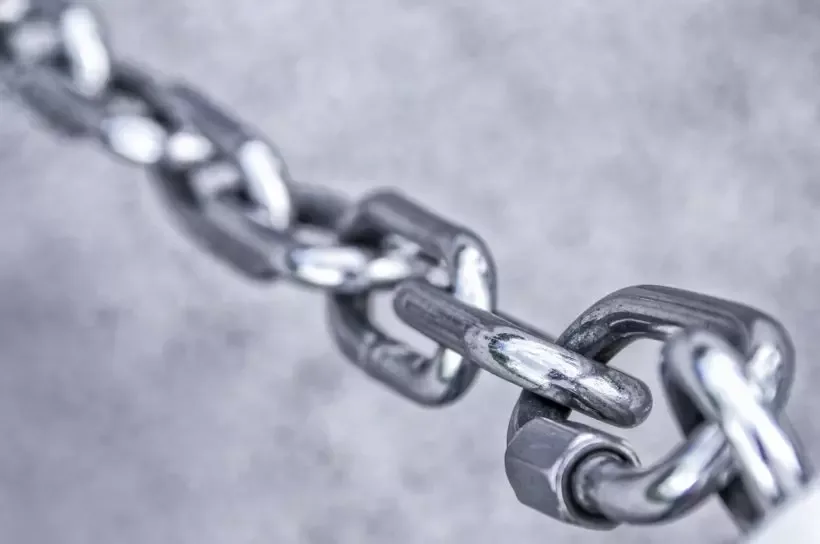How does chain liability work for self-employed persons?
Chain liability is a term that is increasingly being used, but what does it actually mean for you as a self-employed person or as an organization? We at Striive explain it to you in understandable language in this article, so read on quickly!
If you hire a company to carry out an assignment, that company can in turn hire another company to do a specific part of the work. This creates a so-called 'chain' of companies that can all be responsible for certain obligations, such as paying taxes and premiums.
Chain liability and payroll tax
In this chain, it may happen that a company is unable to pay the payroll tax (the tax and premiums that must be paid on the wages of employees) to the Tax Authorities. In that case, the Tax Authorities can hold your company responsible for those unpaid amounts, and you are therefore liable as a 'chain partner'.
This is called chain liability. It may sound a bit complicated, but in a sense it is about you potentially becoming the victim of the financial consequences if someone in the chain does not have their affairs in order. Of course you want to avoid that.
An example of chain liability in construction
Imagine that you hire a contractor for a large construction project. This contractor can in turn hire a number of subcontractors for specialist work. If one of these companies is unable to pay its tax obligations due to financial problems, the Tax Authorities can turn to you for payment of these costs. Even if you are not directly responsible for the work that the other company carries out, you can still be presented with the bill. This is what chain liability is all about.

What is hirer liability?
In addition to general chain liability, there is also a special variant, called hirer liability. This mainly applies in situations where you, as a client, hire someone through a temporary employment agency or secondment agency. In that case, you work together with a 'hirer' who lends out a professional to perform work under your supervision. Now suppose that the lender does not pay the payroll tax or VAT that must be paid on the salary of that employee, then the Tax Authorities can hold you as the hirer liable for the outstanding tax assessments. This means that you run the risk of having to pay for something that you have no direct control over. It can be quite difficult to get that money back from the lender.
Chain liability mainly occurs in the construction sector
Chain liability also occurs in other sectors in which tangible work is carried out, such as agriculture or the clothing industry. Work in which no tangible result is delivered, such as consultancy work, generally does not fall under chain liability. It is therefore good to know in which sectors you can encounter this type of liability, so that you can anticipate this in time.
Always ensure good administration
If you work as a self-employed person with chain partners and subcontractors, it is important that you ensure good administration. For example, keep a good record of the amount of wages, payroll tax and VAT that the subcontractor must pay. This will help you assess and limit any risks. You can also ask the subcontractor or lender for a certificate of good payment behaviour. This will give you insight into their history of tax payments, so that you know whether they are meeting their obligations on time. These types of precautions can ensure that you are not faced with any surprises.
Opening a G-account
One way to reduce the risks of chain liability is to open a so-called G-account. This is a special bank account that is blocked for the payment of taxes and payroll taxes. When you open a G-account, your client deposits the money for tax payments directly into this account and this money can then only be transferred to the Tax Authorities.
This way you can be sure that the money needed for tax payments is kept safe, even if one of the companies in the chain has financial problems. A G-account provides a safety net to limit the risks of chain liability, and it can be especially important if you work with subcontractors or lenders. Opening a G-account is relatively simple. You apply for this with the Tax Authorities, after which you sign the agreement together with your bank. It is important that you keep this account well and only use it for deposits relating to payroll taxes and taxes. If you work with subcontractors who are involved in the chain, it may be wise to open a G-account together. In this way, you ensure that the money goes directly to the Tax Authorities, without the risk of problems arising somewhere in the chain.
Now you may be wondering: do I, as a self-employed person, really have to deal with chain liability? The answer is yes, you too can have to deal with it, although as a self-employed person you are usually the party hired by a client. If you hire another company to carry out work, that company can again employ staff, which makes you vulnerable to chain liability. This also applies if you hire someone through a temporary employment agency or if you work with a company in the clothing industry, for which separate legislation applies.
There is plenty to do to reduce risks
Chain liability is a serious matter, but as a self-employed person you can take measures to reduce the risks. For example, by working with reliable companies, keeping the correct administration and, if necessary, opening a G account, you can reduce the chance of being held responsible for the tax assessments of others. Although it can sometimes be difficult to completely eliminate all risks, you can prevent many problems by acting consciously and carefully. In this way, you remain legally and financially protected as a self-employed person, and you can carry out your work with peace of mind, without worrying about unforeseen costs that you should not actually have to bear. Read more about important legal aspects for freelancers here.
Chain liability can cause considerable problems for your company
Imagine that you hire another company for a specific part of your project, and that company then hires other companies. In such a situation, a chain of companies is created that are all responsible for paying payroll taxes, such as wage tax and national insurance contributions (for example AOW premiums). If one of these companies fails to pay these payroll taxes, the Tax Authorities can hold your company (and other companies in the chain) liable for the outstanding payments. This is called chain liability and can result in an enormous financial burden.
As a self-employed person, the situation is somewhat different
Because you, as a self-employed person, do not pay payroll taxes on your own income, you are not automatically liable for chain liability. As a self-employed person, you may encounter this situation if you hire a company to do work for you, and that company uses personnel. Even if you hire an employee through an employment agency, you may be liable for payroll taxes and VAT as a self-employed person if the employment agency or hired company does not make these payments.
In such a case, it may be wise to apply for a G account. This prevents the Tax Authorities from holding your company liable for the payments of another company in the chain. It is important to make clear agreements about this with the subcontractor or lender, so that you know exactly which part of the payment goes to the Tax Authorities and which part to the hired company itself.

But how can you reduce the risks of chain liability?
It is wise to always request a statement of payment behaviour from the subcontractor or lender. This is a document in which the company confirms that it has paid all payroll taxes and VAT up to that point. This allows you to check whether the party you are working with has its affairs in order and does not pose a risk to you as a client. It is also important to keep a good administration of the amounts that you have to pay in wages, payroll taxes and VAT. This ensures that you always know how much must be deposited into your G account and prevents confusion.
Stricter legislation from January 2025
The introduction of stricter legislation from January 2025 makes it even more important to be well prepared for the risks of chain liability. From that moment on, the Tax and Customs Administration will fully enforce bogus self-employment. This means that companies that hire self-employed persons for work that they do not perform independently can receive a fine or additional assessment. This will be tackled strictly and the government wants to combat bogus constructions and offer the labor market more security. Employers and self-employed people will have a one-year transition period to demonstrate that they are taking action against bogus self-employment, but it is clear that companies and self-employed people need to pay close attention to their obligations and risks. If you get it right, you can ensure that your company is not held liable for unpaid taxes or premiums from your subcontractors. This will protect you and your business from unforeseen costs and potential legal problems.